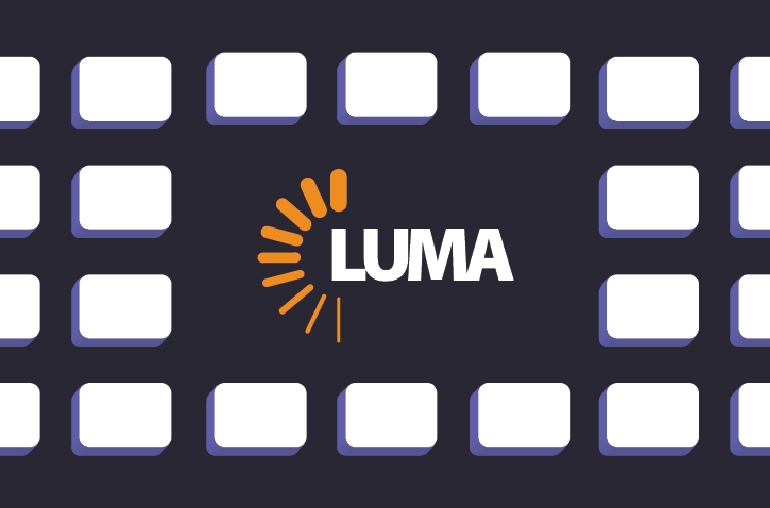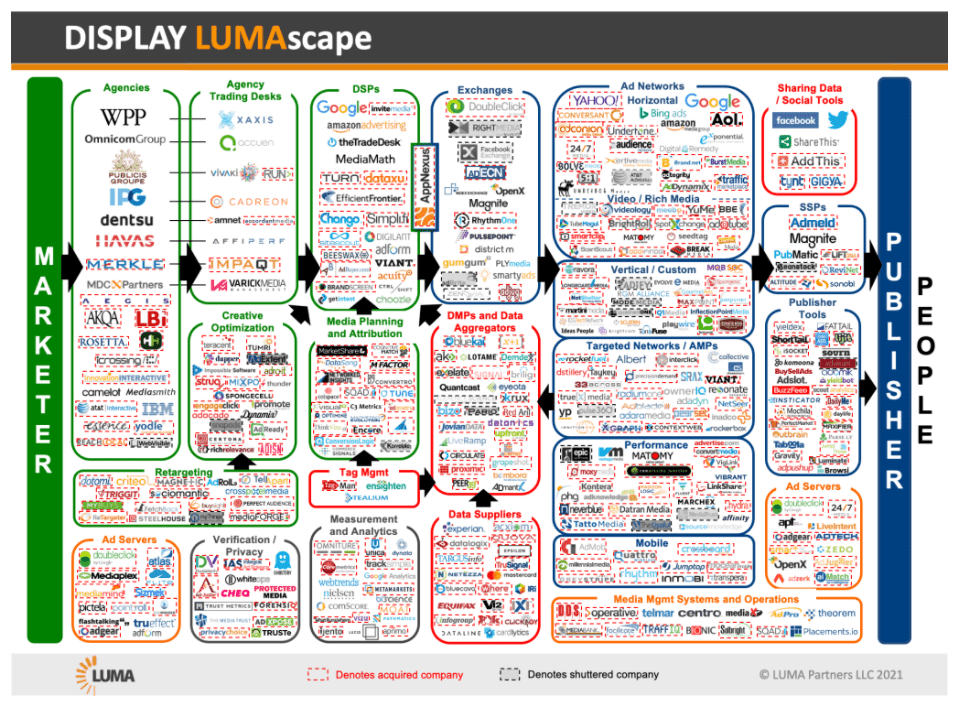Lumascape is an online map that categorizes different entities in the ad tech ecosystem.
Since its inception, the ad tech industry has evolved greatly and is now an ecosystem in itself. This ecosystem comprises various parties, often working under a supply chain model.
It can sometimes become difficult to distinguish between different participants of this supply chain. This is exactly what the Display Lumascape soughts to help marketers, publishers, advertisers, and other parties in the ad tech industry with. And it is because of this that Lumascape has garnered such popularity.
For leveraging Lumascape effectively, it is important to know about the various categories that make up the map. This post talks about what Lumascape is and the different elements that are present in it to simplify the concept for publishers.
What is the Display Lumascape?
The Display Lumascape, or Luma landscape, is a map that categorizes different companies functioning in the ad tech ecosystem on the basis of their primary purpose.
Terry Kawaja, an ad tech banker, started off this venture in 2010 by organizing an ad tech industry map created by Nick Macshane, the founder of Progress Partners. Since its inception, Lumascape has been in demand from various companies in the ad tech industry.
Kawaja told Digiday during an interview that, “People privately would ask if they could get a copy of it and it took on a life of its own”.
According to Michael Katz, the CEO of mParticle, Display Lumascpaes rose to fame because they “brought order to all the chaos” in the ad tech industry. Even though the Lumascape as a concept cannot be said to be perfect, as a lot of companies in it cannot be put under one definitive category, it still provides a way to declutter the ad tech environment to some extent.
Before moving on to understanding Lumascape’s categories, here is a quick look at AdPushup’s position on it.
Where Does AdPushup Fit in Lumascape?
AdPushup, a revenue optimization platform, comes under the ‘publisher tool’ category in the Display Lumascape. In addition to providing premium demand, AdPushup also helps publishers with its range of proprietary technologies, such as header bidding, ad layout testing, and ad block monetization. Our company further puts increased emphasis on improving its existing products for overcoming any inefficient aspects.
For instance, the Hyper Optimizer has recently entered as a solution for dealing with issues related to the Header Bidding ad delivery process.
In short, AdPushup’s aim is to equip publishers with the right kind of technology for monetizing their websites. This means that as a publisher, you don’t need to have deep technical knowledge for using our products, our account managers take care of all that for you.
Now, we are going to talk about what categories are present on the Lumascape and what exactly is their purpose in the ad tech industry.
Lumascape’s Components

Ad Agencies
Ad agencies provide their clients, i.e. advertisers, with marketing campaigns. While ad agencies were considered important a few years ago, these days their significance in the ad tech industry is under scrutiny.
The reason for this is that most publishers are not working directly with ad agencies and are offering marketing campaign services themselves, thereby eliminating the need for ad agencies. Additionally, the demand for branded content has increased considerably these days. Advertisers now are not just looking for marketing campaigns but for solutions that make their customers interested.
This has definitely created an opportunity for publishers as they are able to expand their offerings and earn more revenue.
Agency Trading Desks (ATD)
These companies are basically the programmatic versions of ad agencies. Companies in this category provide technology pieces or services related to marketing campaigns to their clients. While the issues that are being faced by ad agencies may also apply to agency trading desks, these companies have started offering various other products than what their traditional model consisted of for staying relevant in the marketplace.
A lot of ATDs are part of and owned by larger ad agencies, such as Omnicom and WPP, however, a lot of independent ATDs also exist in the ad tech industry.
Creative Optimization
Creative optimization refers to a marketer-side asset, which aids them to know about creatives that perform best. The importance of personalized and relevant ads is often cited in the ad tech industry and creative optimization aims to achieve exactly that.
With creative optimization, advertisers seek to optimize their display creatives on their own. Creative optimization companies help advertisers to see which ad creatives are performing the best.
Retargeting
Retargeting is further related to personalization of ads, but these solutions are majorly for publishers. It is used for serving users with targeted ads based on their interest and previous behavior. This is also where contextual advertising comes into play. With contextual advertising, users are shown ads on the basis of the content of the website they are browsing. Since cookies will soon be unsupported, retargeting based on contextuality will help publishers to serve relevant ads to their users.
Ad Servers in Display Lumascape
Ad servers, such as Google Ad Manager (GAM), serve targeted ads on a publisher’s website depending on the user behavior. Other than this, such companies also store data about users, majorly related to their online behavior, and monitor the number of clicks from users.
A lot of publishers and advertisers use ad servers for delivering enhanced user experience and for keeping a check on how users are interacting with served ads. Other than GAM, OpenX and Kevel (previously Adzerk) are two other popular ad servers.
Verification/Privacy
Just as the name suggests, these companies are responsible for helping Ad ops people with technical issues and issues regarding brand safety. Verification and privacy vendors further help verify any aspect that needs to be checked for both publishers and advertisers.
Considering the increasing number of privacy laws that are coming into existence, such as GDPR and CPRA, these models are projected to become more important in the ad tech ecosystem, especially for publishers.
Demand-Side Platforms (DSP)
DSPs cater to the needs of advertisers or marketers. These companies manage real-time auctions, help advertisers look for inventory, and buy inventory. Basically, DSPs ensure that advertisers are provided with the best possible inventory.
Some of the advantages of using DSPs for handling auctions include better campaign management, expert assistance, access to better and a variety of inventory, and improved targeting. Due to the advent of programmatic advertising, DSPs have become highly significant for advertisers and the ad tech industry.
Media Planning and Attribution
Media planning and attribution modelling have added significant value to the ad tech ecosystem for both advertisers and publishers. Through media planning, advertisers or marketers can get to know how frequently they should serve ads to their audience, what resources they should leverage for increasing the impact of advertising, and on what channels the audience should be targeted in what way.
The impact of media planning can further be enhanced by attribution modelling, since it lets publishers know how users are interacting with the content or ads served to them. If advertisers are aware of how customers are actually making their way to their products or services, the impact of advertising can be improved.
Data acquired through digital attribution is of great help when it comes to targeting relevant audiences.
Tag Management
Tags are small snippets of codes that are used for tracking display ads, visitors, and conversions. While using tags may be a simple thing for publishers who know coding, it may become a difficult task for those who do not have that kind of technical knowledge.
This is where tag management comes in. Companies who provide tag management services put together all third-party code snippets in a way that makes them editable and easy solutions. You may or may not need tag management solutions depending on your website and use-case.
For example, if you need to change tags quickly, set parameters to tags, and implement new tags rapidly then tag management solutions will be important for you.
Measurement and Analytics
Metrics such as viewability hold high importance for publishers, as they aid in monitoring ad performance and audiences on the website. All the data that is collected about users and about the website, including traffic and the number of users, helps in understanding user behavior. By using this kind of data, publishers can provide improved user experience and, in turn, improve their earnings.
Publishers should however be aware about what is the right kind of user data. For publishers, first-party data holds high importance, and its significance is further predicted to increase due to the imminent demise of cookies.
Google analytics is probably the most used tool when it comes to measurement and analytics. But a lot of other alternatives to it exist in the market as well.
Ad Exchanges in Lumascape
An ad exchange is basically a marketplace for advertisers and publishers. Ad exchanges facilitate real-time bidding between all the parties including, publishers, advertisers, ad networks, ad agencies, DSPs. and SSPs. Publishers/advertisers can connect directly with ad exchanges or via SSPs/DSPs.
Google’s AdX has been a popular choice among publishers. If a publisher doesn’t have access to an AdX reseller, Google AdX is of high significance for them.
Data Management Platforms (DMP) and Data Aggregators
DMP vendors are responsible for managing, storing, and organizing data for publishers and advertisers/marketers. A DMP solution is used by publishers and advertisers to analyze and organize data, which includes first-party, second-party, and third-party data.
Publishers and advertisers can then use this organized data for targeting audiences properly. Data aggregators also function in a manner similar to DMPs in the ad tech industry.
The significance of these platforms however is now being questioned, as third-party are being phased out by Google and have already been blocked by Apple’s Safari ITP and Mozilla’s Enhanced Tracking Protection.
Data Suppliers
Data suppliers are not that different from data aggregators. These vendors essentially provide or sell data to third parties. Such services can get publishers out of the throes and help in targeting relevant audiences.
However, as mentioned above, data suppliers might also be facing the same issues as DMPs and data aggregators due to the rising focus towards user privacy.
Ad Networks
The different types of ad networks that have been categorized in the Display Lumascape are:
- Horizontal
- Vertical
- Display
- Native
- Targeted/AMPs
All types of ad networks help publishers in monetizing their websites. An ad network makes sure that a publisher is able to sell their inventory at the highest possible price. On the other hand, ad networks also make sure that advertisers are provided with the best inventory.
Ad networks are basically part of the digital advertising ecosystem and have helped in simplifying the process involved in programmatic advertising.
Supply-Side Platforms (SSP)
SSPs basically provide the same services as DSPs, but for publishers. Publishers can manage their inventory, serve ads, and earn revenue by using SSPs. These platforms provide a way for publishers to present their inventory to various ad exchanges, ad networks, and DSPs, thereby opening up the inventory for various buyers to bid on.
The availability of SSPs and DSPs allows publishers to conduct real-time auctions with ease. These platforms have added considerable value to the programmatic advertising ecosystem.
Also read: Best SSPs for Web Publishers
Display Advertising Performance in Lumascape
Companies that come under this category provide customized performance and programmatic solutions for a variety of aspects, such as responsive design, video ads, and social media campaigns. Such solutions help publishers to analyze the performance of their display advertisement and then plan and strategize accordingly for providing enhanced services.
Media Management Systems and Operations
These vendors majorly help advertisers with planning and analytics related to media campaigns. With this kind of data analytics, advertisers can take strategic decisions when it comes to media planning and management.
Much like several other companies categorized in the Display Lumascape, some companies under media management systems and operations may offer other services as well.
Sharing Data/Social Tools
Social tools, such as listening platforms, publishing platforms, and competitive analysis platforms are ideal for publishers who earn revenue through social traffic. These platforms can be a great way to compile data from social media channels, which will further aid in targeting them in an effective manner.
However, publishers should beware of some other parties stealing data about their users while leveraging social tools.
Publisher Tools in Lumascape
These vendors provide publishers with technical tools that aid them in gathering important data, which further allows them to target audiences in a better way. For example, heat maps let publishers know where users are clicking on their websites.
There are a number of other publisher tools available in the market these days, which can add significant value to a publisher’s inventory. Publishers should however, make sure that they use the right tools, because not every tool can be of value to every type of publisher.
Final Thoughts
It’s true that the ad tech ecosystem is getting more complicated as it evolves. While on one hand it may seem that too many unnecessary parties have made their way into the supply chain, it is important to understand that they add value to the industry in some way or another.
A category may not seem like it serves your needs but for some other publisher or advertiser, those services may very likely be indispensable.
Lumascape has cleared the confusion surrounding the roles of several such companies in the ad tech industry to a large extent. By consulting these maps, publishers, advertisers, and marketers can keep track of where a company stands in the industry and see which ones serve their needs best.
Frequently Asked Questions:
The Display Lumascape, or Luma landscape, is a map that categorizes different companies functioning in the ad tech ecosystem on the basis of their primary purpose.
Display lumascape has following components:
Ad Agencies
Agency Trading Desks (ATD)
Creative Optimization
Demand-Side Platforms (DSP)
Ad Servers in Display Lumascape
Measurement and Analytics
Tag management
Data Management Platforms (DMP) and Data Aggregators

Shubham is a digital marketer with rich experience working in the advertisement technology industry. He has vast experience in the programmatic industry, driving business strategy and scaling functions including but not limited to growth and marketing, Operations, process optimization, and Sales.








